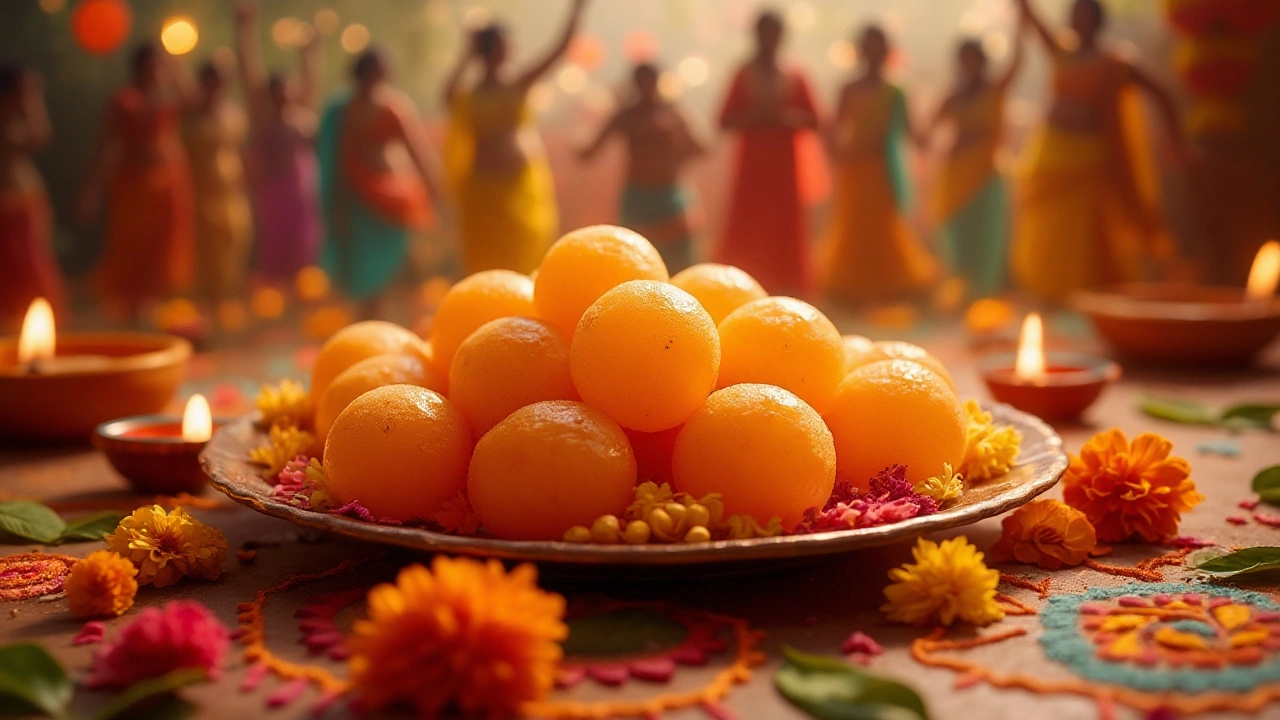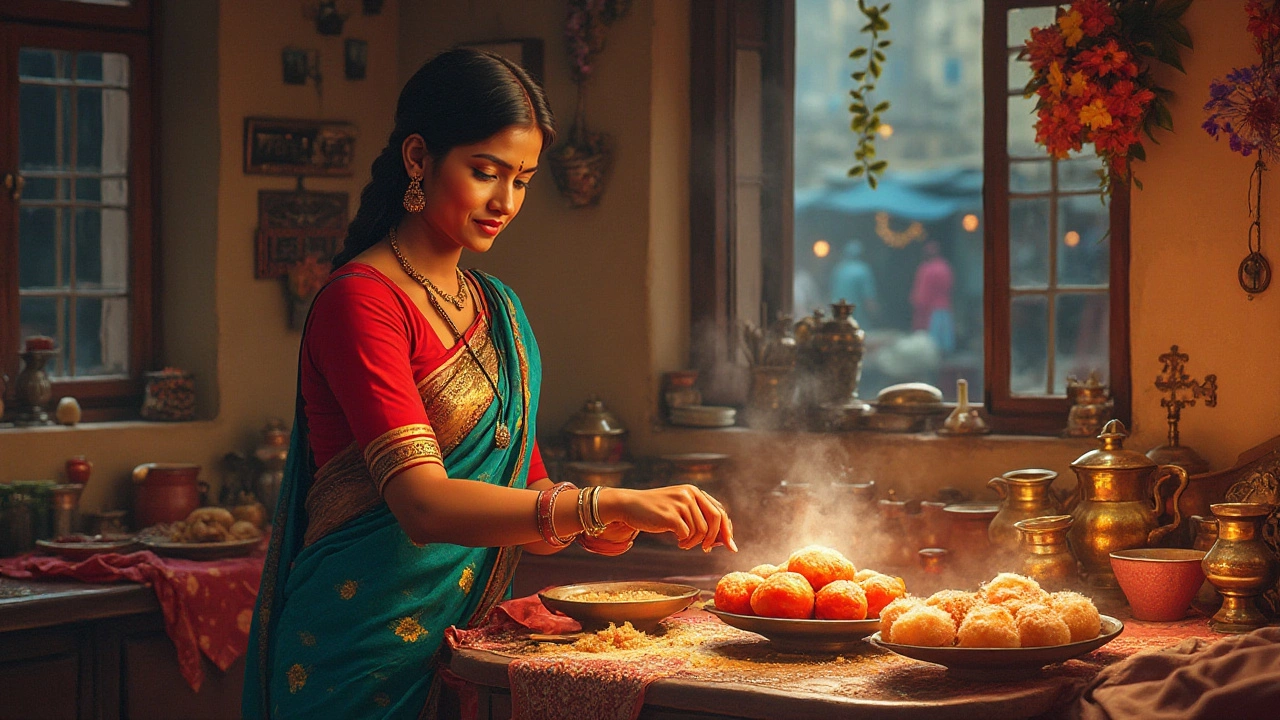Ah, the enticing world of Indian sweets—a wonderland of flavors and colors that promise delight in every bite. Across India, various desserts hold a special place in the hearts of many, yet one stands tall among the rest: the cherished Gulab Jamun. Known for its enchanting sweetness and melt-in-the-mouth essence, this dessert is more than just a treat; it’s an emotion that resonates with festivities and joyous occasions.
Dive with me into the journey of Gulab Jamun as we uncover its history, delve into its classic recipe, and explore some interesting variations that have emerged over time. Whether you’re a seasoned pro in the kitchen or just starting your culinary adventure, there’s something about this sugar-soaked dumpling that draws everyone in. Ready to roll up your sleeves and get into the flavorful tale of Gulab Jamun? Let’s get started!
- The History of Gulab Jamun
- Ingredients that Make It Special
- The Art of Perfecting Texture
- Festive Symbolism in Indian Culture
- Modern Twists and Variations
- Tips for Making Gulab Jamun at Home
The History of Gulab Jamun
Gulab Jamun, a name that echoes sweetness and tradition, traces its roots back to medieval India—a time when culinary arts were flourishing under the influence of invading cultures. Interestingly, its beginnings aren’t originally Indian. This beloved dessert is believed to have been influenced by the Persian dish, 'Luqmat-al-Qadi,' brought to India by the Persian invaders. The dish was eventually adapted to suit the local palate and ingredients, resulting in what we now celebrate as the quintessential Indian sweet, Gulab Jamun. The name itself is derived from two Persian words: 'Gulab,' referring to rose water syrup, and 'Jamun,' a term for a traditional Indian fruit, perhaps to reflect its aesthetic resemblance.
The renowned food historian K.T. Achaya notes in his works, "Gulab Jamun embodies a tale of mingling influences, a synthesis of culinary artistry that epitomizes the journey of sugar and milk in Indian history."
During the Mughal era, the art of confectionery took a monumental leap as royal kitchens became melting pots of culinary innovation. The Mughals, particularly known for their sophisticated palate, embraced milk in their desserts thoroughly—a key reason why richer, milk-based sweets like Gulab Jamun gained popularity. The method of transforming milk to khoya or mawa, which lays the foundation for this dessert, was perfected to cater to aristocratic tastes. Over centuries, this fusion of saffron, cardamom, rose water, and fried indulgence turned Gulab Jamun into an imperial favorite and a staple at every grand occasion.
As with many renowned dishes, variations of Gulab Jamun slowly spread across other regions of India, picking up unique local flavors as they went along. Some regions of India prepare the dessert without khoya, using bread or sweet potatoes—an adaptation indicative of local resources and preferences. Despite these variants, the classic recipe, with its fried dough being soaked in blissful syrup, holds an unrivaled charm. In Northern India, it often graces the tables during Diwali and as a celebratory sweet at weddings, while Southern India cherishes it during festivals like Pongal.
The popularity of Gulab Jamun has extended beyond India, finding fans across South Asia and the Middle East. This dish exemplifies how food travels beyond borders, adapting yet retaining a core essence that captivates generations. The modern era has seen even more twists to the classic, with some chefs introducing innovations like saffron-infused versions or serving them with ice cream. This speaks volumes about its adaptability and universal appeal.
| Region | Variant |
|---|---|
| Southern India | Jaggery-infused Gulab Jamun |
| Western India | Pistachio-stuffed Gulab Jamun |
| Northern India | Traditional Khoya-based Gulab Jamun |
Ingredients that Make It Special
When you sink your teeth into a perfectly made Gulab Jamun, it’s not just the taste that captures you—it’s the harmony of textures and flavors, each note carefully orchestrated by its ingredients. At the heart of this beloved sweet lies a simple yet divine blend of ingredients that create its characteristic soft, creamy center and its luscious golden-brown syrupy exterior.
The main star of Gulab Jamun is khoya, or milk solids, which is traditionally prepared by boiling milk until most of the moisture evaporates. This ingredient lends the dessert its delightful richness and is sometimes substituted with milk powder for convenience, without compromising on the flavor. Khoya gives the Indian sweet its authentic, robust flavor that resonates with anyone who has had the pleasure of tasting it. Then there's the role of flour—usually fine wheat flour or semolina—mixed carefully with the khoya to create the essential structure of the dumpling.
Sugar is, undoubtedly, the next critical player, used both inside the dough and generously as the soaking syrup. Infused with aromatic cardamom pods, rose water, and sometimes saffron, this sugar syrup is what transforms the otherwise humble dumpling into a decadent delicacy. The importance of the syrup cannot be overstated; its precise balance of sweetness and aroma is what elevates Gulab Jamun from ordinary to extraordinary. But did you know that the syrup should be warm but not boiling when the hot dumplings are immersed in it? This ensures a perfect absorption rate where flavor burst occurs right upon tasting.
"Gulab Jamun is more than just a dessert—it's an embodiment of joy that transcends the richness of its ingredients," writes renowned chef Sanjeev Kapoor in his book on Indian cuisine.
The process also involves the art of skillfully frying the dumplings to a perfect golden hue. Ghee, or clarified butter, traditionally serves this purpose, imparting a distinctive aroma and flavor that is hard to replicate with alternative frying mediums. Frying must happen on low to medium heat to ensure the dough cooks thoroughly from within while achieving the ideal color outside. The patience required in this step is a testament to the love poured into its making.
When discussing recipes variations and adaptations, some modern twists embrace ingredients like coconut powder or paneer to add unique textures and flavors. In recent years, some innovative chefs have even played with flours like almond or cashew to cater to health-conscious individuals without losing its essence. Despite these variations, the warmth and hospitality embodied in every bite of traditional Gulab Jamun remind us how enduring and endearing this classic dessert is within Indian culture.

The Art of Perfecting Texture
In the world of Indian sweets, achieving the right texture often stands as the hallmark of a delicious and memorable dessert. When it comes to Gulab Jamun, this is especially true. The ideal texture of a Gulab Jamun is softly sponge-like on the inside, with a smooth, evenly browned crust. It should be light enough to absorb the sweet syrup without falling apart, creating a harmonious balance of flavors and sensations with every bite.
Several factors contribute to the ultimate texture of Gulab Jamun. First, the choice of ingredients plays a pivotal role. Traditionally made from khoya, which is reduced milk solids, the quality of your khoya will greatly influence the final product. Fresh, homemade khoya often yields the best results because it retains the natural creaminess necessary for a perfect Gulab Jamun. However, using milk powder as an alternative is common today, as it simplifies the process without compromising too much on flavor.
The next crucial step is the precision in combining your ingredients and kneading the dough. Too little moisture, and your Gulab Jamun may turn out dense; too much, and they may dissolve in the frying pan or syrup. Achieving the right consistency—a dough that is moist yet firm enough to hold shape—is essential. Gentle rolling is key here; the smoother the ball, the more evenly it will cook. Frying these in ghee at the right temperature ensures they cook slowly, developing that desired golden hue.
"Gulab Jamun is not just about sweetness; it is a journey of textures that leads to an unforgettable taste experience," says renowned chef Kunal Kapur, highlighting the importance of texture in traditional desserts.
Equally important is the soaking process. After frying, Gulab Jamun needs to be bathed in a warm sugar syrup flavored with cardamom, saffron, or rose water. The temperature and concentration of this syrup are significant—warm syrup helps the balls absorb the sweetness better, allowing them to swell without becoming undone. Timing is everything here, as leaving them soaked just enough helps balance the moisture content, preventing them from being soggy.
Lastly, storage can influence texture. While Gulab Jamun is often prepared in advance for events, serving them fresh is vital for experiencing the best of both worlds: soft, juicy interiors contrasting with the firm exterior. Even refrigeration can alter texture, making it essential to gently warm them before serving to restore their inviting softness.
Festive Symbolism in Indian Culture
It's a familiar scene in India, one that's as vibrant and colorful as the country itself: a gathering of friends and family, ornate lamps casting a warm glow, and amidst the laughter and the music lies an array of delectable dishes, crowned by a platter of Gulab Jamun. These soft, syrupy delights are more than just the highlight of dessert tables; they're a tapestry of tradition and emotion, woven into the cultural fabric of India. Festivals and celebrations are incomplete without their arrival, and their presence often signals the crescendo of a joyous occasion. Uniting people under a shared love for sweets, Gulab Jamun acts as an ambassador of goodwill and joy at weddings, Diwali parties, and Eid celebrations. Its journey from the kitchen to the center of the celebration is one of countless rituals—each preparing and sharing of Gulab Jamun embodies the spirit of community that is distinct to Indian festivities.
In Indian culture, sweets are not merely treats; they are imbued with symbolism that transcends their sweetness. Gulab Jamun, with its enticing flavor, is often viewed as a representation of prosperity and happiness. An iconic presence during weddings, this Indian sweet signifies the sweetness of a new journey, blessed by abundance. Its delightful taste is believed to bring sweetness to relationships and good luck to new beginnings. The significance is not just limited to its deliciousness but extends into the spiritual realm too. Many see the offering of Gulab Jamun to deities as a humble request for blessings and good fortune. There is a saying among some regions that no prayer is complete without a sweet finish, and what better confection than a perfectly crafted Gulab Jamun to signify one's devotion?
The role of Gulab Jamun during festivals like Diwali is grandiose and ceremonial. It often accompanies the lighting of diyas and the skyward flow of colorful fireworks—each bite celebrating the triumph of light over darkness. Each sweet, spherical morsel, when shared with neighbors and friends, invokes harmony and strengthens bonds. It's a metaphor for life, teaching us that the chaos of the frying process followed by a slow soaking in sugar syrup—a journey through heat and sweetness—is what gives it depth and character. Much like life’s challenges that are followed by joy and fulfillment. During Diwali, families frequently prepare large batches, not just for personal consumption but as tokens of sharing love and blessings with the community.
Gulab Jamun also features prominently during the holy month of Ramadan. Breaking the fast with this indulgence is common, and it stands as a testament to resilience and gratitude. The indulgence is shared with a community, strengthening ties that bind, and embodying a spirit of togetherness and unity. The symbolism of Gulab Jamun runs deep through regional stories and traditional tales, with each bite reminding the people of the blessings of togetherness and good fortune. "Cooking is like love; it should be entered into with abandon or not at all," Maya Angelou once said. And so it is with Gulab Jamun—a labor of love that sweetens not just the palate but the heart.

Modern Twists and Variations
In recent years, the beloved Gulab Jamun has transcended its traditional form to inspire a variety of modern twists and taste-bud tingling variations. Culinarily adventurous chefs and home cooks alike have begun incorporating diverse ingredients and innovative techniques, breathing new life into this centuries-old treat. Among these modern plays is the addition of unusual flavors such as rose water, cardamom, and even saffron to the syrup, the latter lending a warm and luxurious gold touch to the classic dessert. Some daring enthusiasts opt to infuse the dough itself with unexpected flavors, like chocolate or pistachio, resulting in a delightful surprise for first-timers.
Another notable twist on this iconic sweet is dehydrating or baking Gulab Jamun to create a new kind of texture. More and more cooks are experimenting with substituting ingredients in a bid to cater to the health-conscious crowd. Whole-wheat flour replaces all-purpose flour for a fiber boost, while coconut sugar or other natural sweeteners enhance the health factor without compromising the 'Gulab Jamun' charm. Also, plant-based enthusiasts can rejoice in the growing popularity of vegan versions, using almond or soy milk to replicate the authentic essence.
Global Influence and Fusion Flavors
As Indian sweets gain more presence beyond their homeland, Gulab Jamun has had interesting renditions that reflect global tastes and ingredients. For instance, in Western countries, some creative chefs have served these treats with ice cream, contrasting the warm, spongy delicacies with a cool, creamy partner. There's even 'Gulab Jamun cake,' an inventive dessert where flavors of the traditional sweet permeate moist layers, capturing the delicious spirit in a new form. As a unique touch, the syrup may be crafted with maple or vanilla, adding a delightful fusion profile that compliments the timeless treat.
On the modern dining scene, fusion desserts incorporate elements like spiced chai, which cuts through with a slight spiciness, harmonizing with the syrupy sweetness of the Gulab Jamun. These sweets, in varied shapes and sizes, such as mini balls or even doughnut-like versions, engage a wider audience, continuously redefining how people enjoy this dessert.
"As the world becomes more interconnected, our cherished foods travel and transform—a symbol of cultural exchange. Gulab Jamun is one such delicacy, continually reimagined by innovative minds while preserving its nostalgic appeal." ― Culinary Arts Journal
These innovations have not only expanded the dish's appeal but also kept its rich history and tradition alive in an ever-evolving food landscape. Whether you stick to the traditional recipe or indulge in modern variations, the experience of savoring a bite of Gulab Jamun remains a journey of flavors and joy unmatched by any other sweet.
Tips for Making Gulab Jamun at Home
Preparing Gulab Jamun in your own kitchen is not just a culinary task; it's a journey filled with anticipation and taste discoveries. The secret to perfecting this beloved Indian sweet lies in the delicate balance of ingredients and techniques. Start by choosing the right ingredients—full cream milk powder is essential as it provides the rich texture that characterizes a classic Gulab Jamun. When mixing, ensure your dough is smooth and soft like a gentle cloud. It's crucial to knead with a light hand, preventing the mixture from becoming overworked and dense.
The frying process is where many falter, but fear not. Heat your oil to the right temperature; neither too high, which risks burning, nor too low, that leads to greasy results. A moderate flame allows the Indian sweets to take on a beautiful golden hue that's just right. Many suggest testing the oil beforehand with a small dough piece to gauge readiness. Pay attention to how fast it rises and turns color, adjusting your flame accordingly. When they're ready, the Gulab Jamun should be carefully lifted and immediately immersed into a warm syrup. The syrup's warmth is key to allowing these delightful balls to soak up every drop, making them perfectly syrup-laden.
Crafting the perfect sugar syrup requires just as much attention. Traditional recipes call for an infusion of rose water or cardamom, adding layers of flavor that elevate this sweet to its well-loved status. Ensure the sugar completely dissolves in water before introducing these delicate flavorings. As Swati Aggarwal, a renowned Indian culinary expert, advises,
"The art of making perfect Gulab Jamun lies in the synchronization between the dough, frying, and syrup preparation. Each part of the process is a note in a melodious tune that culminates in the dish's divine taste."Letting the fried dumplings rest in the syrup for an hour enhances their flavor and texture, making patience a sweet virtue in this recipe.
For those with a creative streak, experimenting with modern twists can bring a fresh take on this classic. Consider infusing saffron in your syrup for an exotic aroma, or experimenting with unconventional fillings like pistachios to surprise palates. If you’re aiming for a better shelf life or unique taste, some home cooks venture into creating baked versions, which bring a different texture and are slightly healthier. An important key that seasoned cooks stress is always to taste your syrup—it should be perfectly sweet with an enchanting hint of the rose or cardamom to bring out that distinct Gulab Jamun allure.
